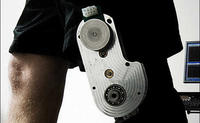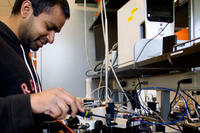-
New method uses gunshot residue to determine caliber, type of weapon used in crime
Researchers have developed a method to determine the caliber and type of weapon used in a crime by analyzing gunshot residue (GSR); using near-infrared (NIR) Raman microspectroscopy and advanced statistics, the new technique may play a pivotal role in law enforcement cases and forensic investigations
-
-
Knee-strapped power harvester to do away with batteries

Battery-powered devices may soon be a thing of the past; researchers have created an innovative energy harvester to power some of the latest wearable gadgets; the energy harvester, strapped to the knee joint, converts knee motions into energy
-
-
New device allows users to scale walls, mountain faces
A group of mechanical and aerospace engineering students, using engineering principles, basic math, and ingenuity, have designed a system which would enable special operations force personnel, first responders, and members of search and rescue teams to scale buildings or mountain faces under a variety of conditions
-
-
Seabed carpet could harness wave energy
A synthetic “seabed carpet” that mimics the wave-damping effect of a muddy seafloor could be used to extract energy from waves passing over it. As well as offering a new way to produce clean and cheap electricity, the carpet — which has not yet been built — could be used to protect coastal areas against strong waves and provide areas of safe haven for boats in stormy seas
-
-
Electrified snail produce electricity from natural sugar in its body
The world’s first “electrified snail” has joined the menagerie of cockroaches, rats, rabbits, and other animals previously implanted with biofuel cells that generate electricity — perhaps for future spy cameras, eavesdropping microphones, and other electronics — from natural sugar in their bodies
-
-
New side mirror eliminates blind spot for drivers

A side mirror that eliminates the dangerous “blind spot” for drivers has now received a U.S. patent; the subtly curved mirror dramatically increases the field of view with minimal distortion
-
-
Silkmoth inspires novel explosive detector
Scientists, imitating the antennas of the silkmoth, Bombyx mori, designed a system for detecting explosives with unparalleled performance; made up of a silicon microcantilever bearing nearly 500,000 aligned titanium dioxide nanotubes, the device is capable of detecting concentrations of trinitrotoluene (TNT) of around 800 ppq 1 (that is, 800 molecules of explosive per 1015 molecules of air), thus improving one thousand-fold the detection limit attainable until now
-
-
Sandia Labs technology used to clean up Fukushima after disaster
A Sandia Lab-developed technology — crystalline silico-titanate, or CST — is a molecular sieve that can separate highly volatile elements from radioactive wastewater; the technology has been used to remove radioactive material from more than forty-three million gallons of contaminated wastewater at Japan’s damaged Fukushima Daiichi nuclear power plant
-
-
New explosives detection based on micro- and nano-cantilever beam sensors
A team of engineers is investigating micro- and nano-cantilever beam sensors for explosives detection; micro- and nano-cantilever beam sensors offer a distinct advantage in that they are small, very responsive, and very sensitive; their sensitivity and selectivity can also be tuned by modifying the surface treatment
-
-
Mass spectrometry for detection of trace quantities of explosives
The detection of trace quantities of explosives is critical to defending civilian populations from terrorist attacks; researchers have developed a method of modifying a commercial electrospray ionization source for ambient detection of explosives on surfaces
-
-
Using nanomaterials to build safer, longer-lasting roadways
Asphalt is now made from petroleum, so it is very expensive; researchers tested two types of nanoclays, adding 2-4 percent by weight to asphalt; this is a smidgeon — less than half of a percent of the total weight of the asphalt pavement itself, but it made a big difference, and could make for safer, longer-lasting roadways
-
-
Novel radiation detection technology to thwart nuclear terrorism
Researchers at the Georgia Tech Research Institute (GTRI) are developing ways to enhance the radiation-detection devices used at ports, border crossings, airports, and elsewhere; the aim is to create technologies that will increase the effectiveness and reliability of detectors in the field, while also reducing cost
-
-
New DNA-based chemical sensor acts as an all-electronic nose
Chemical sensors are very good at detecting a single substance or a class of chemicals, even at highly rarified concentrations; biological noses, however, are vastly more versatile and capable of discriminating subtle cues that would confound their engineered counterparts; even highly trained noses, however, do leave a certain ambiguity when relaying a signal
-
-
Smart gas sensors offer better chemical detection

Smart chemical sensors can detect chemical weapon vapors or indicators of disease better than the current generation of detectors; they also consume less power, crucial for stretching battery life on the battlefield, down a mineshaft, or in isolated clinics
-
-
Android app for radioactivity detection

Just-release Android app uses software and the smartphone’s camera to measure radioactivity levels, allowing users to find out whether their environments are safe; the software is the civilian version of technology developed under contracts with the U.S. Department of Defense and with DHS
-
More headlines
The long view
New Technology is Keeping the Skies Safe
DHS S&T Baggage, Cargo, and People Screening (BCP) Program develops state-of-the-art screening solutions to help secure airspace, communities, and borders
Factories First: Winning the Drone War Before It Starts
Wars are won by factories before they are won on the battlefield,Martin C. Feldmann writes, noting that the United States lacks the manufacturing depth for the coming drone age. Rectifying this situation “will take far more than procurement tweaks,” Feldmann writes. “It demands a national-level, wartime-scale industrial mobilization.”
How Artificial General Intelligence Could Affect the Rise and Fall of Nations
Visions for potential AGI futures: A new report from RAND aims to stimulate thinking among policymakers about possible impacts of the development of artificial general intelligence (AGI) on geopolitics and the world order.
Keeping the Lights on with Nuclear Waste: Radiochemistry Transforms Nuclear Waste into Strategic Materials
How UNLV radiochemistry is pioneering the future of energy in the Southwest by salvaging strategic materials from nuclear dumps –and making it safe.
Model Predicts Long-Term Effects of Nuclear Waste on Underground Disposal Systems
The simulations matched results from an underground lab experiment in Switzerland, suggesting modeling could be used to validate the safety of nuclear disposal sites.
